Touratech-USA’s General Manager, Paul Guillien, and Chief Riding Officer, Iain Glynn, compare two BMW boxers: The 2011 oil-cooled R1200GS and the new 2013 water-cooled R1200GS.
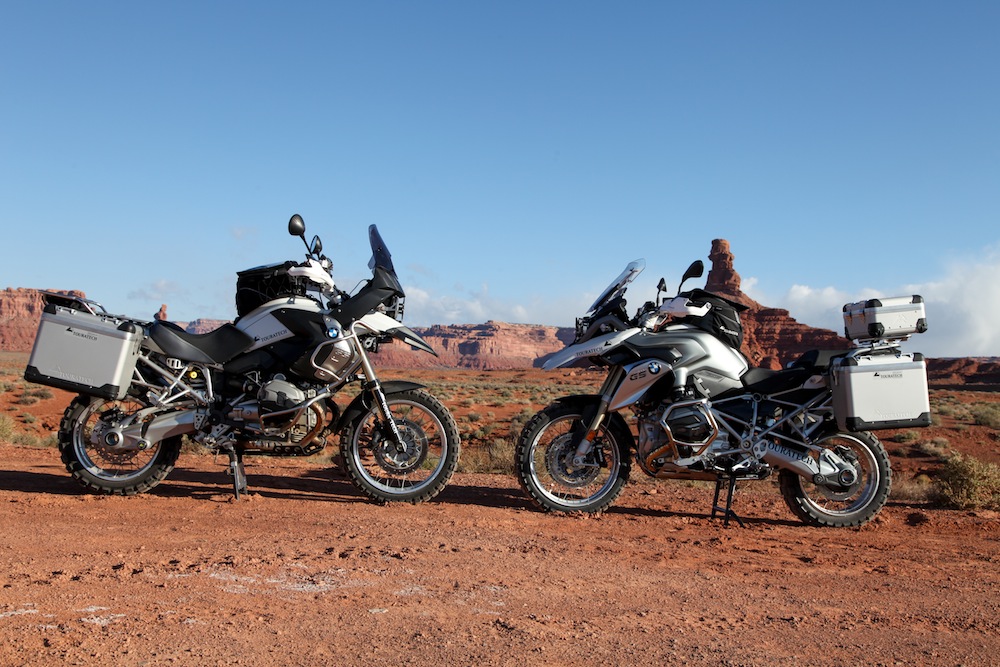
Full Video Transcription:
We’re going to compare the water-cooled R1200GS to the outgoing model, the oil-cooled R1200GS. We’re going to see how different these bikes really are.
Iain: The build quality on the new water-cooled is typical BMW. The quality is excellent. The execution is stellar. I think in terms of styling, I really like the new bike, but it does have a little bit more of a street orientation to me. It just seems a little more like a street bike in terms of its dress. The older bike, it just seems a little more rugged and a little more adventure-like to me.
I think the best way we came up with to explain it is when the water-cooled bike starts to get dusty and dirty, it kind of looks like a dirty street bike, where as the oil-cooled GS, when it gets dirty you think, “That’s just a GS.” That’s what it looks like.
Paul: I agree, but that being said, I still love the look of the new bike. I still like the styling on it and I would like that parked in my garage, I think, as opposed to the oil-cooled bike when just purely looking at the specifications.
Iain: Yeah, exactly, and the LED headlight is just wicked. It’s really cool-looking. The ergonomics package as a whole, actually, I appreciate the way they changed it on the new bike. It feels more like you’re sitting on top of it rather than in it, and the reach to the bars just felt really natural.
Paul: Yeah, I like the reach to the bars. On the older bikes, I sometimes felt like I was reaching too far, it just felt a little bit stretched out. With the new bike the bars are in a little bit more. It’s much more comfortable. It definitely feels more street oriented to me, but with the bar risers, you can get them up to where it’s comfortable to ride off-road as well.
Iain: The adjustable wind screen fitted to the water-cooled R1200GS is a brilliant piece of engineering. It creates a very effective and quiet wind bubble, and it’s easily adjustable on the fly.
Paul: I’ve ridden motorcycles with adjustable wind screens in the past, and typically you have to stop and adjust some screws and adjust the windscreen. You never think about it ahead of time until you get out on the road and you’re like, “Oh yeah, I forgot to do that.” With this bike, you can reach forward with your left hand and twist it up into the higher position, or adjust it back down when you go off-road, or anywhere in the middle that works for you. It really puts up a much bigger bubble. It’s a great feature, and I really like being able to use that when I transition from off-road to on-road or vice versa.
Iain: Yeah, they spent a lot of time in the wind tunnel. This bike gives you a really clean bubble of air to sit in. It’s quiet on the helmet. I didn’t have any complaints about it at all. Honestly, the wind handling reminds me quite a bit of the Desierto fairing that Touratech makes for the older bike.
Paul: So, most of the first day we spent down in southern Utah, we were on pavement switching back and forth between the bikes, and that’s where we noticed the biggest difference. The water-cooled GS is just hands down much better on the pavement. It’s got more power. It handles really well. The throttle response is fantastic, and when you get off of that bike and get onto the oil-cooled bike, you can really feel it. It takes a lot more work on your hand and your arm on the throttle to get the bike to do the same thing. The new bike does all the same things the old one does. It just does them much faster.
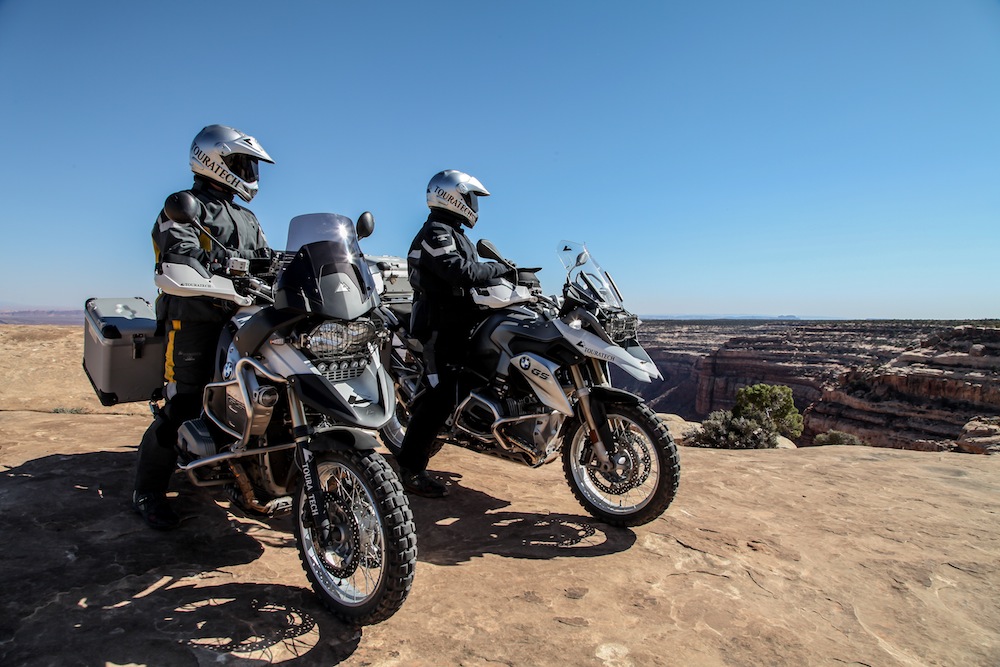
Iain: I did like the quicker steering on the oil-cooled bike a little bit better. You don’t feel it unless you’re trying to make really fast transitions, but I thought the water-cooled bike was a little more neutral mid-corner. It’s certainly easier to ride on the street. The new water-cooled R1200GS Boxer engine makes 125 horsepower, compared to 110 on the oil-cooled model.
Paul: Iain’s a much faster rider than I am. So, I got on the water-cooled GS, and he was on the oil-cooled GS. We got next to each other, kind of did a rolling start, got after it a little bit to see what happened.
Iain: Well, it’s embarrassing to say, but you definitely beat me.
Paul: For the first time.
Iain: The oil-cooled bike makes it a little more torque off the bottom. In first and second gear, it was pretty even. You put maybe half a bike length on me, and then as we got up into higher speeds, the water-cooled bike just starts walking right away. The difference in power is very, very obvious in that situation.
Iain: My favorite feature of the new water-cooled bike, hands down, I know you’re going to think it’s silly, but cruise control. That’s right. On a bike like this, you buy a 1200 because you’re going to be spending some time on the highway. The cruise control is just amazing. Every motorcycle should have cruise control if you’re going to ride on the highway.
Paul: I have to say, it’s not a feature I would have sought out. but after using it this morning, I had a sleeve that wasn’t adjusted right, and I was able to set the cruise control and take both hands off and fix that Velcro. That’s something you couldn’t do without that.
Iain: Yeah, couldn’t do it. Another thing I noticed about a difference between these two is that we’ve had a couple of very cold mornings when we’re starting the day here. In the water-cooled bike, the fuel injection and the fly-by wire throttle just seem to be a little bit more refined in the mixture that they’re providing. This bike starts right up in the morning. You don’t have to nurse the throttle. You don’t have to do anything, and the mixture is just spot-on. The oil-cooled bike took a little while to warm up in the morning, a little hard to start.
Paul: When we started on both mornings, it was 25, 26 degrees. So, it was a very cold start. The new bike just started immediately. The oil cooled bike took a little bit of work. It took a few tries to get it sparked up and running right.
Iain: The water-cooled 1200 is equipped with wider tires, both front and rear. A 120 series front tire replaces a 110 series, and at the back, a 170 series replaces a 150 fitted on the older bike.
Paul: I think that it is just downright exciting, the power that this thing puts out. I think that when people ride this for the first time, they’re going to be like, “Wow! This thing really gets up and goes.” It is right now power, even at speed on the highway. When you ask it to get around semi to make a quick move, it does it immediately. I think overall, very exciting. I think the motor is just about perfect on the top end. I couldn’t ask it to do any more.
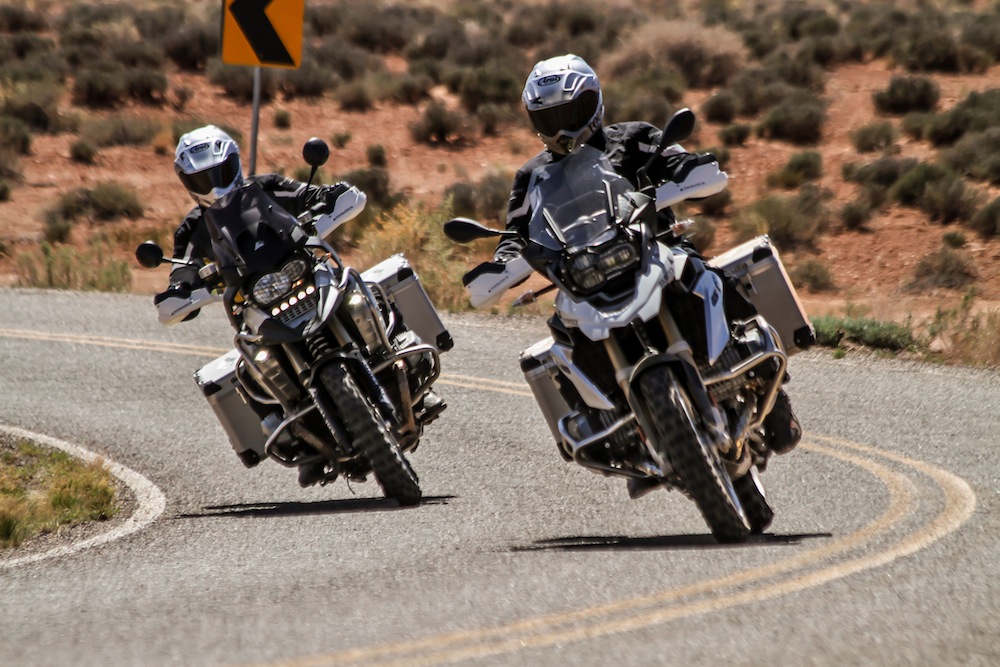
Iain: Yeah, on that point, the bottom end is, I think, the only place that the new engine is a little bit softer than the old bike. On the oil-cooled boxer, you get a little more fly-wheel effect and a little more grunt at really low RPMs. For some of the shoots we were doing, we were driving really slowly in small circles and over some rocks and rough terrain, and I found that the water-cooled bike had a little more tendency to stall under load at really low RPMs than the older bike does.
Paul: So, it’s interesting though, despite the fact that this has considerably more horsepower than the old bike, it seems to be getting better fuel economy.
Iain: Yeah, I think a lot of that has to do with the redesign of the engine, the way the air flows through, the higher flow rates in the head, and all that. I think that this engine is quite a bit more efficient than the old one.
Paul: When I was over in Germany a few months ago talking to some of the guys that were on the design project for the new water boxer, one of the criteria for those guys is that they not give anything up in the off-road category. They wanted to make sure that it stayed true to its lineage and was a proper adventure bike that could handle off-road. I think they did a fairly good job at that. I think that the older bike is just a touch more comfortable, easy to ride off-road, but they did a great job with the electronics package making this higher horsepower bike still manageable off-road.
Iain: The water-cooled Boxer is equipped with a multi-plate wet clutch, compared to a dry clutch that separates the engine and the transmission on the oil-cooled bike. The wet clutch is much more resistant to high temperatures seen in off-road riding.
Paul: It was a lot of fun experimenting with the different ride modes on the bike. It really changes the character of the bike from street to dynamic to the rain setting, the off-road, the off-road pro, the Enduro, or the Enduro Pro. It really changes the power output, the way the brakes work, the ESA, and the traction control. It’s a lot of fun, and you really quickly figure out what you like, what works for you. I think the Enduro Pro was the best for me, just the way the regular Enduro Pro is. When I got in deep sand or steep loose things, I had to turn the traction control off. So, those are the kind of the two settings that I found most comfortable off-road.
Iain: So, that Enduro Pro mode is something that is new for this bike. What it does is it allows you to put the bike into a setting where the throttle turn is very aggressive and the traction control is turned down a bit, so it allows you a little bit more wheel spin than it would on the street, but the really trick thing is that it disables the rear wheel ABS while still enabling the front wheel ABS. So, you’ve got a bike that you can steer with the back wheel. You can ride at a pretty good pace and stay reasonable on the throttle, but at the same time, in a panic situation or a fast stop, you can grab a whole bunch of front brake and you won’t lose the front end in a corner. It’s really, really nice.
Paul: So, Iain told me to do that, and I was terrified to try it, but he insisted. So, I got going really fast on some loose dirt and didn’t touch the rear brake at all, but just hammered on the front brake, and you can actually hear the back tires skidding. So it actually engages the rear brake without you touching the pedal at all, and keeps the bike straight. You can literally pull as much hard brake as you want, and you can feel the ESA releasing as you go. It is really a good safety feature. You can really stop the bike in that mode.
Iain: So, like you just said there, “you can feel the ESA releasing as you go.” That actually is the case. This bike is outfitted with the dynamic setting. So, what that does is when the computer tells the bike that the anti-lock brakes are activated, it actually softens the damping on the suspension to help keep the tire in contact with the ground. So, not only is the ABS working on the front end, but it also softens your suspension right away and gives you the most opportunity to stop. It’s really nice.
The electronics package on this bike, I think, is one of the biggest factors that actually makes it comparable, off-road, to the oil-cooled bike. The extra fly wheel mass and the slower spooling engine on the oil- cooled bike caused it to make just an awful lot of traction when you’re going down gravel roads, accelerating, going up hills, or even coming out of a turn. In the water-cooled bike, the motor spools a lot quicker, which is nice for the street, but off-road it can be kind of a handful. The ride modes have done an excellent job of taming what is a much more powerful bike.
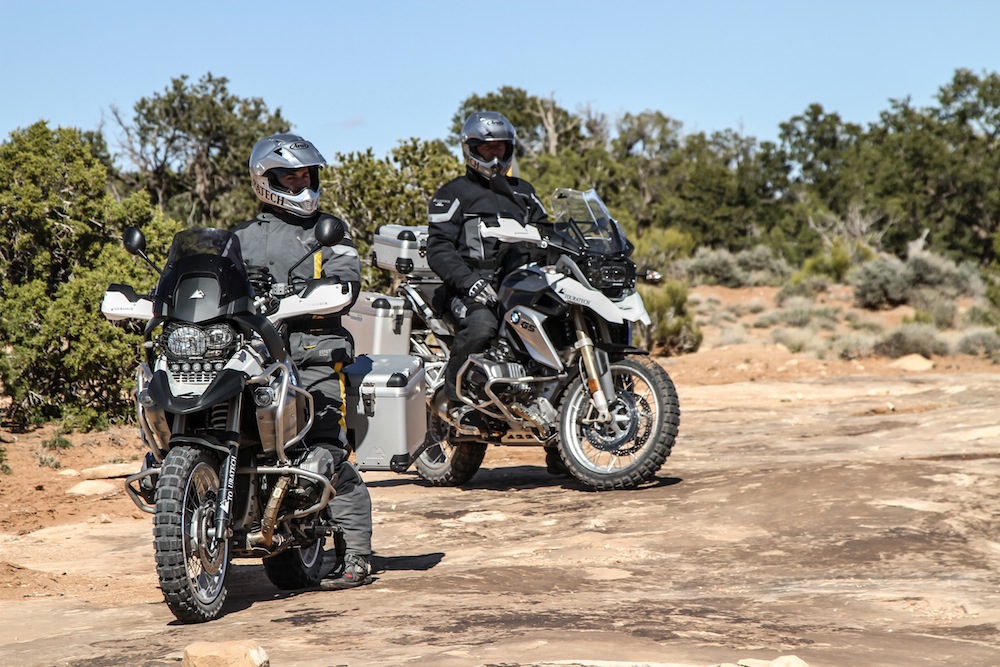
Paul: It is a much more powerful bike. They’re both fairly large bikes, and the thing that I really like about this bike off-road is that they narrowed it up in the middle. There’s a nice place for your knees. You don’t feel like your knees are pushed out on this wide seat like you do on the oil-cooled bike.
So, I think they get a lot of points, in terms of the ergonomics and fit and feel of the bike. It just feels a little bit lighter when you’re managing it off-road.
Iain: It is important to know that just like with the oil- cooled bike, you can easily turn off all of the computer intervention on the bike. So, you can have all the hooligan fun off-road that you did on the old one.
Paul: We went up the Moki Dugway a few days ago, and that’s a fairly steep ascent. It’s washboarded, it’s loose, and even in the Enduro Pro mode, I wanted to switch the traction control off, because it was really cutting the power on those washboards. So, it’s nice that they’ve given us riders the ability to turn off the computer completely when we really need to just have a manual set up on the bike.
Iain: There are five different ride modes available on the water-cooled R1200GS. Rain gives you a smooth throttle application, heavy intervention with traction control, and a road biased ABS. Road mode gives you a slightly more aggressive throttle turn, less invasive traction control, and the same road-tuned ABS system. Dynamic gives you a very aggressive throttle turn. It allows some wheel spin at the back for sliding the motorcycle around corners on pavement when riding very aggressively, and the ABS is tuned the same as in road mode.
There are two off-road settings included in ride modes. Enduro mode gives you a slow throttle turn. The traction control is recalibrated for use off pavement so that you can slide the motorcycle more than you could on the pavement. You can also loft the front wheel slightly. The ABS is de-tuned to allow you to brake more effectively on loose surfaces, and the ESA setting goes to soft to maximize the amount of time the tires are on the ground. Enduro Pro mode is specifically tuned for riding the GS off-road with Navi tires. You get a very quick turn throttle. You get relaxed traction control, and you get a unique ABS system that gives you full control over the back wheel with no ABS intervention, while still having full ABS control over the front tire so you have an increased safety margin.
Iain: So, one of the biggest things that all these changes add up to that I think is going to be huge for BMW is that when you get off of a Japanese motorcycle, or a street bike, or pretty much any other motorcycle available on the market right now, you can get onto this motorcycle here, the water-cooled Boxer, and you feel at home pretty quickly. With the oil-cooled bike, there were a lot of acquired tastes that a lot of people just found too different to really start enjoying the motorcycle. BMW has done a great job in really ironing out a lot of those acquired tastes and making a motorcycle that’s just universal and easy to ride.
Paul: The other thing is I think this bike will out compete more with street touring bikes. Some of the guys that were going for a pure street touring bike like an Kawasaki Concourse or an FJR will take a look at this bike, because it has similar power on road but still has the off-road capability. It’s something that a lot of guys are thinking more and more about as the adventure movement really gains a lot of traction in the motorcycle world.
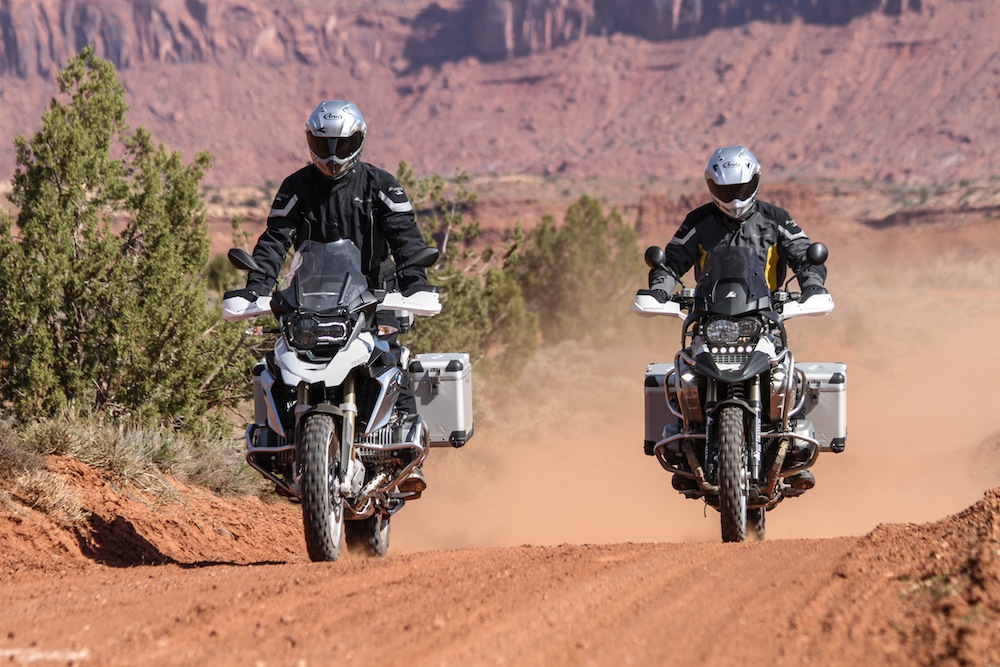
Iain: So, just to sum it up, these two bikes are very different, but very much the same in all the important ways. What it comes down, between the two of them is that the water-cooled bike seems to be a much better bike going down the road. It has more power when you need it, and with the electronics, it’s not there to get you in trouble. What do you think?
Paul: I think that the new bike is exciting, much better on the road, and a lot more fun on the pavement. I think that off-road, it’s still a lot of fun to ride the oil-cooled bike, but I have to say that on ergonomics and the narrow in the middle features that they built into the new bike, it’s still an awful lot of fun off-road.
Iain: So, if it came down to it and you had to pick one, what would it be?
Paul: I think the new one. I really have had too much fun riding this thing off-road the last few days. I don’t want to give it up.
Iain: I’m not quite ready to make that call yet. I have an oil-cooled GS in my garage, and as good as this one is, the oil-cooled bike just has a lot of familiarities that I’m used to. There are a few things I miss when I get onto the new one. A lot of the personality of the Boxer family, there are a few key things that just aren’t there anymore, and I miss them.
Click HERE to see our complete line of accessories for BMW’s water-cooled R1200GS and R1200GS Adventure.